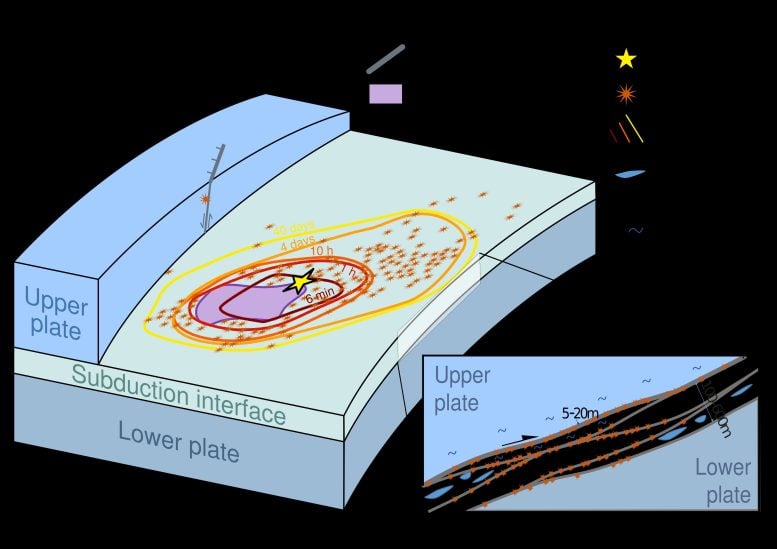Recent research suggests that earthquakes in subduction zones occur on complex networks of fault planes rather than on a single fault plane. The discovery, derived from detailed seismic data collected in Ecuador and analyzed through artificial intelligence, challenges conventional wisdom about how seismic stress is released. The study also provides new insights into the behavior of aftershocks and could have significant implications for future earthquake modeling and risk assessment in subduction zones.
The first high-resolution images of earthquake fault zones changed our understanding of earthquakes.
The idea that earthquakes release stress through a single strong quake along a single fault plane may need correction. New research conducted by the Karlsruhe Institute of Technology (KIT) in collaboration with the GFZ German Research Center for Geosciences and other international institutions shows that the earthquake occurred in an area containing multiple faults, some of which are parallel.
The authors say the findings could help create more realistic models of earthquakes and seismic hazards in subduction zones.The research has been published in the journal nature.
An international team led by first author Caroline Chalumeau investigated a series of earthquakes in Ecuador, on the west coast of South America. There, the Pacific Plate subducts beneath the South American continental plate. Repeated subduction causes very severe earthquakes. Taiwan’s recent series of earthquakes, the main one of which killed nine people in early April and caused widespread damage along Taiwan’s east coast, can also be attributed to subduction.

This sketch shows a 100 to 600 meter thick seismic zone in which fault planes (5 to 20 meters thick) and ruptures lie. Image credits: Dr. Caroline Chalumeau, Dr. Hans Argurto-Detzel, Prof. Andreas Rietbrock, Dr. Michael Frietsch. Prof. Onno Oncken, Dr. Monica Segovia, Dr. Audrey Galve: Seismological evidence for a multi-fault network at the subduction interface. Nature, 2024.
The series of earthquakes in Ecuador analyzed by the team began on March 12, 2022, and ended on May 26, 2022. aftershocks. At this time there was a dense network of 100 seismometers in the area. It was built for the High-Resolution Imaging of Subducted Faults in the Pedernales Earthquake Rupture Zone (HIPER) offshore experiment.
Detailed seismic data analysis
Using extremely detailed data from the HIPER experiment and using artificial intelligence, researchers were able to map more than 1,500 earthquakes and their faults at depths of 15 to 20 kilometers at very high resolution. “We observed that the seismicity of the earthquake occurred in a primary zone, so to speak, the main earthquake, and in a secondary zone, the aftershocks,” said first author Dr. Caroline Chalumeau of the Geophysical Institute (GPI) of Karlsruhe Institute of Technology said. “Within the main area, we observed seismicity occurring on several different fault planes, often overlapping each other. In some places, parallel planes of seismicity occurred, while in other places there was only a single plane of seismicity. .
The parallelism of earthquakes has nothing to do with a specific depth. “We found signs that the previous idea that stresses were released by a strong earthquake on a single fault plane may be a thing of the past,” said GPI Professor Andreas Rietbrock. “On the contrary. , we should be talking about a network of faults where a series of ruptures are unleashed in an earthquake.”
Analysis of the Ecuador earthquake series also provides new insights into aftershocks. Chalumo said these earthquakes first occurred near the main shock and then gradually spread in other directions. She concluded from this that the propagation of aftershocks in the region is mainly controlled by afterslips. Professor Onno Oncken from GFZ said: “With this work, Caroline Chalumeau’s team has demonstrated for the first time clear seismological images of seismogenic plate boundaries. On the one hand it confirms existing geological observations and on the other hand it successfully uses new The method explains the propagation of aftershocks. For example, the previous hypothesis that fluid diffusion causes aftershocks is therefore refuted.
The findings are also important for assessing seismic risk in subduction zones. “This research will have implications for future earthquake modeling, but also for the modeling of aseismic slip, that is, plate movement without earthquakes,” says Andreas Rietbrock.
Reference: “Seismological evidence for a multi-fault network at the subduction interface” by Caroline Chalumeau, Hans Agurto-Detzel, Andreas Rietbrock, Michael Frietsch, Onno Oncken, Monica Segovia and Audrey Galve, April 17, 2024 nature.
DOI: 10.1038/s41586-024-07245-y
#Popular #myth #busted #discovery #challenges #earthquake #models
Image Source : scitechdaily.com
